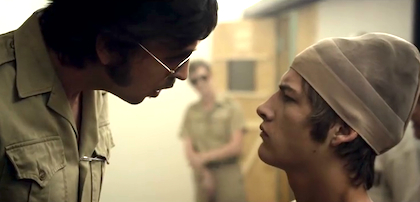'Stanford Prison Experiment' Tells the Ultimate Real-Life Horror Story

If you’ve ever seen an interview with the great horror director John Carpenter, then you have no doubt heard his take on what horror really is, because he always answers that question with the same story. To Mr. Carpenter, there are two types of scary stories, and they date back to the early days when mankind would gather around fires to tell tales. The storyteller points out beyond the fire into the darkness and says that there is a monster out there, and it is coming for us, thus indicating the first type of horror story. The next time they gather, the storyteller gestures to everyone around the fire and says that the monster is in here with us, thus indicating the second type of horror story. The Stanford Prison Experiment is not a horror film, per se, but it certainly has a kinship with the latter story about the darkness existing within us. And that, my friends, is a scarier thought than all of the boogey men out there hiding under beds and in closets.
If you read our previous article about the 5 Best Looking Films of Sundance, then you will have seen this film from director Kyle Patrick Alvarez at the top of the list. The film is based on a real experiment held at Stanford University back in 1971. Phillip Zimbardo (a psychology professor with the most '70s name ever) decided to run a two-week experiment to test the effects of prison life on ordinary people. 24 middle class American men were selected and split into two groups: prisoners and guards. The guards were instructed to provide to the prisoners an atmosphere of scrutiny, fear, and a sense of total control that strips them of any feeling of freedom. Zimbardo and his fellow members of the Stanford Psychology Department set up cameras and recording devices and prepared to spend the next 14 days observing their subjects. The experiment was ended abruptly after only 6 days.
The men selected to be guards took their new roles very seriously pretty early on as a result of some minor resistance from the prisoners, who were still just treating the whole scenario as an experiment. Pretty soon, methods of psychological abuse were employed to get the prisoners to comply with orders. It got to be too much early on, and two of the prisoners had to be removed from the experiment after suffering breakdowns. There’s a shot in the trailer above that shows a guard hitting one of the prisoners, and I should point out that this did not really occur. But I understand the film’s need to include it as it acts as a clear representation of the guards’ decision to cross over the line of decency.
The Stanford Prison Experiment is due out in theaters on July 17 after making an impressive debut and winning two awards at The Sundance Film Festival. I have not seen this film yet, so I cannot comment too much more on it, but one thing I can tell you is that I will be first in line to see it, because I was actually introduced to this story at a very early age.
When I was in grade school, my class and I were shown a documentary called Quiet Rage, which detailed the Stanford Prison Experiment and the effects it had on its participants. The fact that the guards decided to begin chipping away at the prisoner’s humanity should not be a surprise to anybody. After all, they were instructed to promote fear and uselessness amongst their tiny prison population, so the fact that it happened was only natural. What was not natural was how quickly these men embraced their new roles, even though they had been psychologically evaluated prior to the experiment and were shown to be average citizens with no preclusion to violence or aggressive behavior. One of the goals of the experiment was to see if men would conform to their environment and their expected responsibilities or if their inner nature would rise above and keep them true to themselves. They not only quickly adapted to their new roles and responsibilities but took them to greater lengths than anybody ever thought.
After the experiment, the guards were interviewed, and they told Zimbardo and his crew that they shocked themselves at how easily they found themselves acclimating to this power and control that had been given to them. And let's not forget the prisoners. Two of them had to be removed early from the experiment because they could not handle being locked up under those conditions, despite the fact that they were merely part of a controlled experiment. Every aspect of this experiment was set up to play against the prisoners and their wants and needs. And why not? Isn’t that what prison is? Aren’t people supposed to be punished by being jailed? But when does the punishment give way to rehabilitation? Or does it at all? Those are just some of the questions and ideas that I look forward to being explored in the film. Another and more thorough documentary on The Stanford Prison Experiment is available on YouTube, and I have included it at the bottom of the page. It takes a good look at the true purpose of the experiment while illustrating the culture clashes and rebellions going on during that time. Humans are capable of a lot of things, and not all of them are good, and on July 17, the world will get a chance to see a film that provides a very scary example of that very idea.
(Screenshot via YouTube)
- Greg McIver, YH Staff



